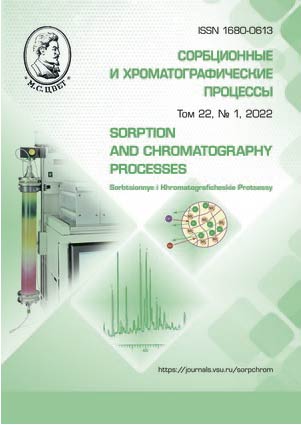Selectivity and retention capacity of composite mem-branes for nanofiltration of heavily polluted wastewater
Abstract
In our study, we analysed the properties of composite membranes and the basic parameters of the wastewater nanofiltration process. The composite NATs-3 membrane was produced on a nylon mesh substrate with a cellulose acetate surface layer. The surface properties of the original substrate and the composite membrane were investigated using a LEO-1430 VP scanning electron microscope (SEM). The membrane retention coefficient was determined by ion composition studied by ion chromatography and atomic absorption spectroscopy.
Wastewater from a landfill was subjected to nanofiltration, with a specific electrical conductivity of 4270 μS/cm. During the nanofiltration process, the permeability of the NATs-3 membrane decreased by 3 times in 60 minutes. The membrane capacity reduced significantly during the first 1-3 minutes of the process. It was due to the concentration polarisation phenomenon induced by the high concentration of dissolved salts and organic compounds. This results in the formation of a gel layer over the membrane surface as well as the sorption of colloidal particles in the membrane pores. The average value of the membrane permeability for wastewater was 0.074 dm3/m2s·KPa at a pressure of 0.65 MPa, which is 3 times lower than the membrane permeability for distilled water.
The results of the study show the average pollutant retention coefficient from wastewater was 0.62. The obtained membrane had high retention coefficient in relation to multivalent ions - 0.84, to heavy metal ions - 0.7, and in relation to the COD and colour of water - of about 0.9. The results equal the performance of a commercial OPMN‑P nanofiltration membrane. The results of the study can be used in membrane technology, chemical technology, and industrial ecology.
Downloads
References
Fazullin D. D., Mavrin G. V., Fazullina L.I., Nasyrov I.A., Helix, 2019,Vol. 9 (5), pp. 5563-5567.
Li Y., Xiong S., Tang X.Y., Wu H. et al., Journal of environmental chemical engineer-ing, 2021, Vol. 9 (6), Article number106371. doi: https://10.1016/j.jece.2021.106371.
Fazullin D.D., Mavrin G.V., Salakhova A.N., Membranes and Membrane Technolo-gies, 2020, Vol. 2, No 2, pp. 115-124. doi: https://10.1134/S2517751620020067.
Kong F.-X., Wang Y.-K., Cao J.-M., Sun G.-D. et al., Environmental Science: Water Research and Technology, 2021, Vol. 7 (12), pp. 2390-2396. doi: https://10.1039/d1ew00523e.
Mohammad A.W., Hilal N., Pei L.Y., In-ternational Journal Of Green Energy, 2004, Vol. 1 (2), pp. 251-263. doi: https://10.1081/GE-120038756
Almeida R., Couto J.M.D., Gouvea R.M., Oroski F.D. et al., Waste Management & Research, 2020, Vol. 38 (10), pp. 251-263. doi: https://10.1177/0734242X20933333.
Matosic M., Terzic S., Jakopovic H.K., Mijatovic I. et al., Water Science And Tech-nology, 2008, Vol. 58 (3), pp. 597-602. doi: https://10.2166/wst.2008.700.
Smol M., Wlodarczyk-Makula M., Skow-ron-Grabowska B., Desalination And Water Treatment, 2017, Vol. 69, pp. 335-343. doi: https://10.5004/dwt.2017.20241.
Wu Y., Yao R., Zhang X., Journal of Environmental Chemical Engineering, 2021, Vol. 9, Issue 3, pp. 105164. doi: https://10.1016/j.jece.2021.105164.
Hezarjaribi M., Bakeri G., Sillanpaa M., Chaichi M.J. et al., Journal of Environmental Management, 2021, Vol. 284, pp. 111996. doi: https://10.1016/j.jenvman.2021.111996.
Fazullin D.D., Mavrin G.V., Shaikhiev I.G., Dryakhlov V.O. et al., Inorganic Materials: Applied Research, 2021, Vol. 12. (5), pp. 1229-1235. doi: https://10.1134/S2075113321050105.
Volkov A.O., Golubenko D.V., Yaroslavtsev A.B., Separation and Purification Technology, 2021, Vol. 254, Article Num-ber: 117562. doi: https://10.1016/j.seppur.2020.117562
Alvarenga A.D., Correa D.S., Journal of Cleaner Production, 2021, Vol. 285, pp. 125376. doi: https://10.1016/j.jclepro.2020.125376.
Fazullin D.D., Mavrin G.V., Shaikhiev I.G., Membranes and Membrane Technologies, 2021, Vol. 3 (2), pp. 107-113. doi: https://10.1134/S2517751621020049.
Park S.Y., Chung J.W., Kwak S.Y., Journal of membrane science, 2015, Vol. 491, pp. 1-9. doi: https://10.1016/j.memsci.2015.05.007.







